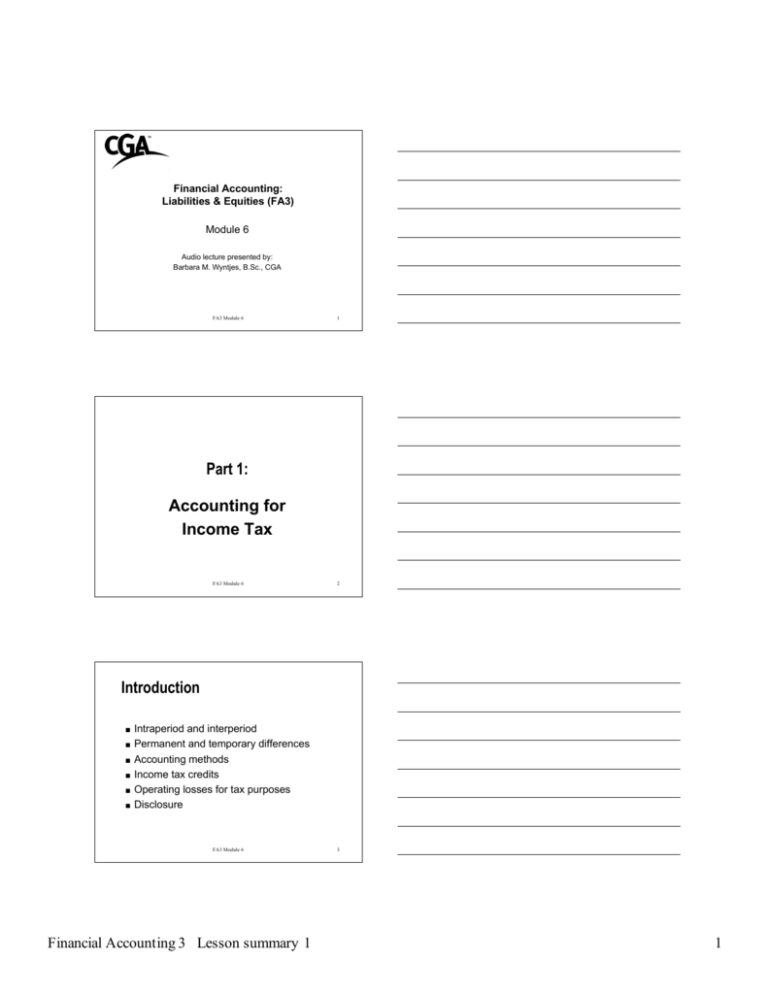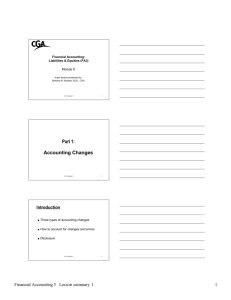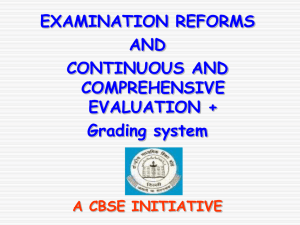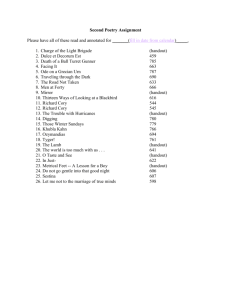Part 1: Accounting for Income Tax Introduction
advertisement

Financial Accounting: Liabilities & Equities (FA3) Module 6 Audio lecture presented by: Barbara M. Wyntjes, B.Sc., CGA FA3 Module 6 1 Part 1: Accounting for Income Tax FA3 Module 6 2 Introduction Intraperiod and interperiod Permanent and temporary differences Accounting methods Income tax credits Operating losses for tax purposes Disclosure FA3 Module 6 Financial Accounting 3 Lesson summary 1 3 1 Intraperiod Tax Allocation Total income tax expense reported according to the nature of the income, gains, and losses giving rise to the tax Income Statement: Continuing operations Discontinued operations (net of tax) Extraordinary gains or losses (net of tax) FA3 Module 6 4 Intraperiod Tax Allocation Three calculations of income tax expense Continuing operations Discontinued operations Extraordinary gains or losses FA3 Module 6 5 Intraperiod Tax Allocation Statement of Changes to Retained Earnings: Capital transactions Restatements of prior periods (correction of errors or changes in accounting policy) FA3 Module 6 Financial Accounting 3 Lesson summary 1 6 2 Assignment A15-1 Req’d 1 See Chapter 15, page 965 And handout 1, page 1 FA3 Module 6 7 Assignment A15-1 Req’d 2 See Chapter 15, page 965 And handout 1, page 1 FA3 Module 6 8 Part 2: FA3 Module 6 Financial Accounting 3 Lesson summary 1 9 3 Taxable vs Accounting Income The difference arises from two types of sources: permanent differences temporary differences FA3 Module 6 10 Taxable vs Accounting Income Permanent differences: Items of revenue, expense, gains, or losses that are reported for either accounting or tax purposes but never enter into the computation of both FA3 Module 6 11 Taxable vs Accounting Income Examples Income Expenses No problem FA3 Module 6 Financial Accounting 3 Lesson summary 1 12 4 Taxable vs Accounting Income Temporary differences: Wherein an item of revenue, expense, gain, or loss arises in determining accounting income in one period and for taxable income in another period Lead to timing differences FA3 Module 6 13 Taxable vs Accounting Income Temporary differences: Determined by comparing accounting balance sheet carrying values with tax values (a balance sheet approach) FA3 Module 6 14 Taxable vs Accounting Income Timing differences: Determined by examining current year differences between accounting and taxable income (an income statement approach) Deferral Method Current method = Liability Method FA3 Module 6 Financial Accounting 3 Lesson summary 1 15 5 Taxable vs Accounting Income Example: CCA versus amortization FA3 Module 6 16 Taxable vs Accounting Income Example: Cash basis versus revenue recognition Warranty expense versus paid Unearned revenue FA3 Module 6 17 Conceptual Issues There are three basic underlying issues: The extent of the allocation Discounting The measurement method The range of temporary differences to which interperiod tax allocation is applied FA3 Module 6 Financial Accounting 3 Lesson summary 1 18 6 Extent of Allocation The three basic options are: 1. Tax payable method - no allocation 2. Comprehensive method - full allocation 3. Partial allocation FA3 Module 6 19 Taxes Payable Method The amount of taxes assessed in each year is the income tax expense for that year Income tax expense = current income tax Corresponds with actual cash outflow Not an obligation as do not owe now Differential reporting Problems FA3 Module 6 20 Comprehensive Allocation Method The objective is to recognize the income tax effect of every item when that item is recognized in accounting net income (according to GAAP). Match revenue and expense to income tax impact Tax effects of all temporary differences are allocated, regardless of the timing or likelihood of their reversal FA3 Module 6 Financial Accounting 3 Lesson summary 1 21 7 Partial tax Method Alternatives that falls between the two extremes of no allocation and full allocation Interperiod income tax allocation is applied to some types of temporary differences but not to all (likely to reverse out in near future) Not for recurring or uncertain reversal Problems FA3 Module 6 22 Discounting Future monetary assets and liabilities are discounted (consistency) Difficulties – estimates and timing Do not discount FA3 Module 6 23 Measurement Issue Interest rate to use Current tax rate – arose at Expected/enacted rate FA3 Module 6 Financial Accounting 3 Lesson summary 1 24 8 Deferral Method Records the future tax impacts by using the corporation’s effective average tax rate in the year that the temporary difference first arose. Income Statement approach - focuses on best matching of revenue and expenses. Does not meet definition of assets and liabilities. FA3 Module 6 25 Liability Method Records the future tax impacts by using the tax rate that will be in effect in the year of reversal (expected/enacted) The future tax impact is recorded on the balance sheet and is updated as the tax rate changes (Balance Sheet approach) FIT amounts meets definition of assets and liabilities FA3 Module 6 26 Liability Method More volatile Net Income More consistent FA3 Module 6 Financial Accounting 3 Lesson summary 1 27 9 Future Income Tax Liability From the perspective of the firm Taxable temporary differences: taxable to the firm in the future = FIT liability Income tax expense not equal to tax payable FA3 Module 6 28 Future Income Tax Liability Example: Accounting Income > taxable income Amortization expense $20,000 CCA $30,000 FA3 Module 6 29 Future Income Tax Asset From the perspective of the firm Deductible temporary differences: deductible to the firm in the future = FIT asset FA3 Module 6 Financial Accounting 3 Lesson summary 1 30 10 Future Income Tax Asset Example: Accounting Income < taxable income Unearned revenue Prepaid FA3 Module 6 31 Future Income Tax Future income tax assets and liabilities are classified as current assets/liabilities or non current Net amounts FA3 Module 6 32 Income Tax Expense Calculation of income tax expense 1. Calculate tax payable. 2. Calculate the change in future income tax. 3. Combine 1 and 2 to obtain tax expense. FA3 Module 6 Financial Accounting 3 Lesson summary 1 33 11 Part 3: Assignment A15-8 Req’d 1 See Chapter 15, page 968 And handout 1, page 2 FA3 Module 6 34 Assignment A15-8 Req’d 2 See Chapter 15, page 968 And handout 1, page 2 FA3 Module 6 35 Assignment A15-8 Req’d 3 See Chapter 15, page 968 And handout 1, page 2 FA3 Module 6 Financial Accounting 3 Lesson summary 1 36 12 Assignment A15-8 Taxes Payable Method See Chapter 15, page 968 And handout 1, page 2 FA3 Module 6 37 Part 4: Assignment A15-13 20X4 See Chapter 15, page 970 And handout 1, page 3 FA3 Module 6 38 Assignment A15-13 20X5 See Chapter 15, page 970 And handout 1, page 3 FA3 Module 6 Financial Accounting 3 Lesson summary 1 39 13 Assignment A15-13 20X6 See Chapter 15, page 970 And handout 1, page 3 FA3 Module 6 40 Assignment A15-13 Schedule See Chapter 15, page 970 And handout 1, page 3 FA3 Module 6 41 Part 5: Assignment A15-29 20X1 See Chapter 15, page 976 And handout 1, pages 4-5 FA3 Module 6 Financial Accounting 3 Lesson summary 1 42 14 Assignment A15-29 20X2 See Chapter 15, page 976 And handout 1, pages 4-5 FA3 Module 6 43 Assignment A15-29 20X3 See Chapter 15, page 976 And handout 1, pages 4-5 FA3 Module 6 44 Part 6: FA3 Module 6 Financial Accounting 3 Lesson summary 1 45 15 Investment Tax Credits Reductions of tax caused by capital expenditure (DR income tax payable) Flow-through method (CR income tax expense) FA3 Module 6 46 Investment Tax Credits Cost Reduction approach The tax credit is recorded as a reduction to capital assets or in a separate deferred credit (contra account to asset). It is amortized over the life of the asset. FA3 Module 6 47 Tax Losses Tax loss = taxable loss on tax return Corporation is entitled to offset the loss against past and future taxable income: the loss can be carried back for three years any remaining loss can be carried forward for seven years (if meet criteria). If the sum of the previous 3 years and next 7 years taxable income is less than the loss, any remaining potential benefit is lost FA3 Module 6 Financial Accounting 3 Lesson summary 1 48 16 Tax Loss Carrybacks DR income taxes receivable and CR income tax expense (recovery) Tax is recovered at the rate at which it was originally paid If loss relates to discontinued/extraordinary, allocate to proper area of income statement FA3 Module 6 49 Tax Loss Carrybacks Advantages No requirement to apply sequentially Recovery maximization strategy FA3 Module 6 50 Text Example See pages 981 to 982 FA3 Module 6 Financial Accounting 3 Lesson summary 1 51 17 Tax Benefit Is the present and future benefit that the company will be able to realize from the tax loss through a reduction of income taxes paid to governments Tax benefit = Tax loss x Tax rate FA3 Module 6 52 Tax Loss Carryforwards Basic Principle – More likely than Not Future benefits of tax loss carryforwards should be recognized in the year of the loss only if there is a greater than 50% probability that the benefits will be realized. FA3 Module 6 53 Tax Loss Carryforwards DR future income tax asset – carry forward benefit (balance sheet account) CR Income tax expense – recovery (income statement account) Use the rate that is enacted for the period in the future if it is known (if not, current rate used) If the rate changes in the future, then the benefit is adjusted based upon the change in the rate FA3 Module 6 Financial Accounting 3 Lesson summary 1 54 18 Tax Loss Carryforwards Recorded loss carry forward benefit unlikely that the benefit will be used, then the benefit should be written off resulting in a decrease in the asset and an decrease in net income If initially unlikely but becomes more than likely, than record it. FA3 Module 6 55 Tax Loss Carryforwards Advantages A loss carryforward recognition decreases the apparent accounting loss The income tax recovery is a credit entry in the income statement, reducing the amount of the reported loss FA3 Module 6 56 Tax Loss Carryforwards Strong earnings history Loss from non-recurring cause Existing temporary differences (CCA) FA3 Module 6 Financial Accounting 3 Lesson summary 1 57 19 Tax Loss Carryforwards FA3 responsible to explain policy and impact of that policy in the financial statements (NOT for calculations) FA3 Module 6 58 Policy Decisions: 1. Use the tax loss as a loss carryback or loss carryforward 2. Claim CCA in the loss year (optional) – if not, increase loss carryforward 3. Refile prior CCA – increase loss used as a carryback. FA3 Module 6 59 Policy Decisions: 4. Record tax loss carryforward – based on likelihood (>50%) 5. Still a greater than 50% probability 6. Still a less than 50% probability FA3 Module 6 Financial Accounting 3 Lesson summary 1 60 20 Impact in Financial Statements Loss carry back Reduces the loss in the current year Increases assets on the balance sheet (Income taxes receivable) Increases retained earnings by reducing the amount of loss charged to retained earnings in the period FA3 Module 6 61 Impact in Financial Statements Recorded loss carry forward benefit Recognizes an asset on the balance sheet (Future income tax asset – LCF) Reduces the loss in the current year Results in an increased retained earnings FA3 Module 6 62 Impact in Financial Statements Do NOT record loss carry forward benefit No effect on the current year’s statements In the year the benefit is used, the income taxes will be reduced (loss carryforward x tax rate in effect during that year) Increase income and increase retained earnings FA3 Module 6 Financial Accounting 3 Lesson summary 1 63 21 Impact in Financial Statements Draw down of carry forward benefit Reduce income taxes payable Reduce future income tax asset – LCF No effect on net income or retained earnings - unless the benefit had to be adjusted to compensate for a change in tax rate FA3 Module 6 64 Disclosure General recommendations for disclosure of the components of the provision for income tax expense: Continuing operations Discontinued operations, extraordinary items and capital transactions Income tax expense should not be combined with other items of expense Future income taxes FA3 Module 6 65 Disclosure Public companies must explain difference between the effective tax rate (income tax expense / pre-tax net income) and statutory rate Loss carrybacks and carryforwards should be segregated between continuing operations and discontinued operations The amount and expiry of unrecognized tax losses. FA3 Module 6 Financial Accounting 3 Lesson summary 1 66 22 Disclosure Cash Flow Statement: only the amounts of taxes actually paid or received for the year. All allocations, whether for temporary differences or for tax loss carryforwards, must be adjusted out. FA3 Module 6 67 Part 7: Past Exam Questions: See Module 6 Handout 2 FA3 Module 6 Blueprint: 11-15% Multiple Choice and / or long answer FA3 Module 6 Financial Accounting 3 Lesson summary 1 68 69 23 Question 6a See Module 6 Handout 2 FA3 Module 6 70 Question 6b See Module 6 Handout 2 FA3 Module 6 71 Multiple Choice i See Module 6 Handout 2 FA3 Module 6 Financial Accounting 3 Lesson summary 1 72 24 Multiple Choice j See Module 6 Handout 2 FA3 Module 6 73 Multiple Choice k See Module 6 Handout 2 FA3 Module 6 74 Multiple Choice l See Module 6 Handout 2 FA3 Module 6 Financial Accounting 3 Lesson summary 1 75 25 Question 8 See Module 6 Handout 2 FA3 Module 6 76 End of presentation FA3 Module 6 Financial Accounting 3 Lesson summary 1 77 26









